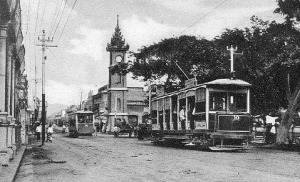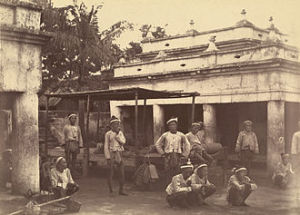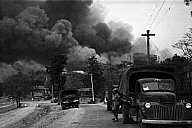Mandalay, April 1942.
One blistering afternoon, about the beginning of April 1942, Mandalay was devastated by a massive bombing raid on the Town, which killed 20,000 and left almost 60,000 wounded – Indians, Chinese and Burmese. Many of the refugee camps were subjected to bombing and machine-gun and cannon attacks which added to the chaos caused by panic-stricken men, women and children streaming out of the camps and homes leaving their belongings behind for the criminal elements to move in.

The mass exodus heading for the bridge to cross over to Sagaing and beyond swept the police out-post at the bridgehead into the river, in a manner of speaking, never to return.
The Japanese had dropped a carefully balanced mix of AP (anti-personnel) and Incendiary bombs in order to inflict maximum casualties and destroy Mandalay as a viable unit by setting fire to large areas of residential complexes consisting mainly of wooden houses.

The famous Wooden Palace known as King Thibaw’s Palace with its unique Wooden Stockade received several direct hits by Incendiaries destroying major portions. It was a beautiful palace built in the early 19th century by King Thibaw who only occupied it for a very short time before being exiled to India.
I was in my little office when the raid took place and our building had several narrow misses with relatively minor damage at the end of the day. There had been little anti-aircraft fire and fighter opposition from our side which literally doomed any lingering sense of loyalty or sympathy for the British (Allied) cause among the Burmese and Chinese elements of the local population.
The Indian mood was somewhat ambiguous; a very large proportion of the troops visible in the area and taking up defensive positions around Mandalay consisted of Indian units with just a handful of British troops which had escaped the Singapore debacle. This visual evidence tended to create a psychological sense of involvement in the fight against the Japanese and this in an involuted sort of fashion, created further tensions between the Indians on the one hand and Chinese & Burmese citizenry on the other. There were also, perhaps, overtones of inter-Buddhist solidarity. However, it may have been, the situation was loaded against the refugees and we realised that it was imperative for them to be cleared out of the area and put on the road to Tamu on an emergency basis.
It is on record that my telegram to the Government of India immediately after the raid was the first intimation received in India regarding the raid and the extent of damage and casualties caused. If memory serves me right the total casualties were reported at 90,000 approximately 30,000 dead. The telegram also contained detailed information concerning material damage including disruption of civic facilities like roads, water and electric supply, hospitals, and communication. The Agent was in Maymyo at that time so the telegram went over my signature. I was considerably elated at receiving a fairly appreciative acknowledgement the following morning from Mr. Bozman, Secretary, Commonwealth Affairs.

By mid-April the Evacuation effort was gradually winding down and I knew that I would have to be on the road soon after ensuring that all camps had been emptied out. As we entered the final week, it became a race against time to complete the seemingly unending list of jobs which required to be attended to before abandoning a living Township and a working administration. Japanese patrols were already operating in the Toungoo area and further north and our intelligence reports indicated that the Advance units were also moving up on an extended front.
As news of the Japanese advance started percolating into the northern districts one could feel a build-up of unrest and tension among the indigenous elements of the population – Shans, Chins, Kachins and of course the Burmese – and it soon became evident that their ire was mainly directed against the Indians who were perceived as being their main exploiters.
There were far too few Britishers to really matter. This provided an added impetus to the plan of clearing Mandalay of all evacuees without loss of time in order to put as much distance between these moving columns and the main Burmese strongholds through which the Route lay.
We estimated, as far as I can remember, that the last column of evacuees would be leaving Mandalay 10th April and I decided to hit the road the next morning after completing a number of winding-up tasks which even then seemed to me to be an exercise in sheer futility. One of these consisted of destroying some crates of Indian currency (brand new and tightly packed) from the Treasury. This proved to be a far tougher assignment than I had, in my innocence, expected. The bundles, tightly packed, simply refused to ignite and we had eventually to hack them into pieces, soak them in petrol and set them alight.

The certification also took quite some time but it was done and that night I took one last turn around Mandalay, looked up some friends who had decided to stay back and, finally, destroyed the Code Books by burning each leaf individually. All that remained to be dealt with was my cycle.
As luck would have it, a transport plane was expected in a couple of days on a final ‘Clean-Up’ sortie and I left the bike with a friend to place it on board with the other junk to be delivered in Delhi if possible. The bike eventually reached Delhi after being shunted around from one Air Force Station to another for six months. The bike or whatever was left of the original remained in my possession till around 1987 when it was gifted away to a keen youngster who would keep it on the road, where it really belonged.
The Agent, Mr. Hutchings, had in the meantime moved on to Kalewa on the Chindwin River together with the Commissioner and a few other officials and it had been agreed that we would meet in Tamu in about a week’s time. The route taken by the trekking columns from Mandalay passed through Sagaing to Monywa (60 miles) and from Monywa to Tamu on the Indo-Burma Border (130 miles) – a cart track passing through the densely forested lowlands between the Chin Hills on the left and the Chindwin River on the right, going north. Since I had only my ruck sac to carry, I managed to maintain a steady 20 – 25 miles per day starting out at 0530 hrs and reaching a Camp or conveniently sited village around 4 p.m. The dry hot summer of northern Burma was beginning to impose its will on the ill-fed and tired columns of men, women and children many of whom were already in the grip of cholera and fading away by the hour due to severe dehydration.
The trek turned out to be one of the more harrowing experiences of my life. Only a few of the trekkers managed to cover the daily ‘quota’ of 20 miles to reach the next Camp; the vast majority could barely complete 7 to 10 miles per day and subsisted on rations carefully saved from previous camps. To assess their physical condition one has to remember that most of these evacuees had been on the road for over a month living on subsistence rations with little or no physical resistance left to cope with conditions to which they were totally alien. The parents carried their young children in addition to varying loads of belongings which they wished to carry with them to the new havens of their dreams. Husbands supported their wives and vice versa. Many were afflicted with cholera and all I could do was to see them break away from the column, stagger or crawl to the water holes at varying distances from the track take a few sips of the already fouled water and collapse, never to get up again.
It was a traumatic sight to see dozens of bodies around each water-hole. Some we were able to bury in shallow graves but there were others who had wandered into the thick forest to find a peaceful and solitary ending with their visions and dreams disappearing in misty silences. Apart from the water-holes, which were mostly some distance from the track, one had to watch the heart-breaking sight of young and old, men, women and children collapsing on either side of the track and having to be left behind as the remorseless tide moved on. The carnage in Rangoon and Mandalay from the Japanese bombing was a matter of war; and therefore acquired a peculiarly impersonal aspect. This was close to the bone. These were people for whom I was in a sense responsible and with whom I had spent quite a few miles. True they were in thousands but many of those who lay along that track happened to be individuals I had come to know. I lent a hand in burying them and carried on.


my uncle, Dr. Anklesaria, played a central role in assisting refugees at Monywa in March-April of 1942, especially in the control of cholera.
I am trying to reconstruct the circumstances in those refugee camps.
Any information which you may have pertaining to these camps in Monywa would be most appreciated.
Sincerely,
Tehmton Mistry